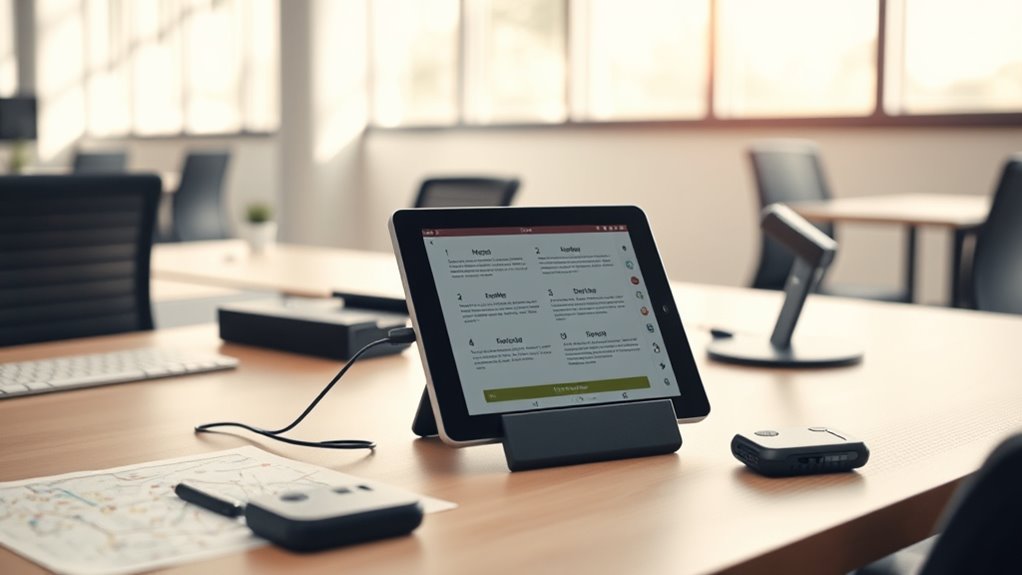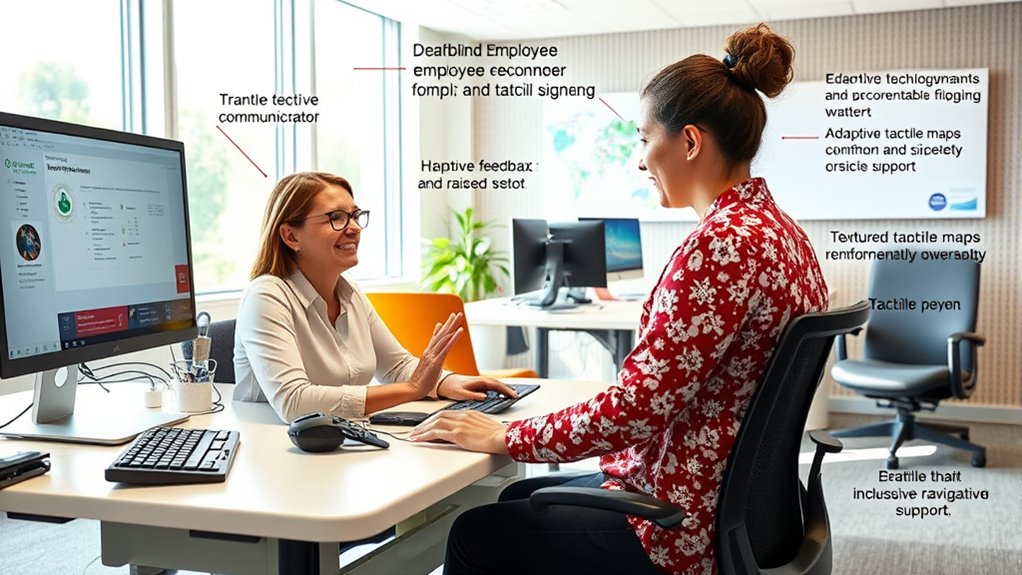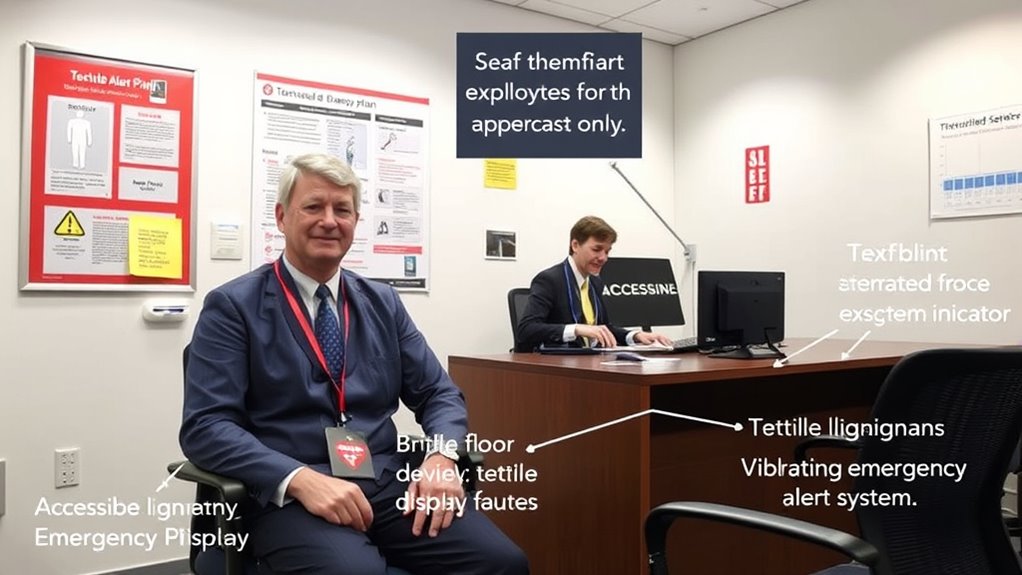To support deafblind employees, you should provide assistive technologies like tactile feedback devices, braille displays, and sign language interpreters. Adjust the workspace with visual alerts, clear pathways, and tactile signage for safety. Foster an inclusive culture through training programs, awareness efforts, and personalized assistance that promotes independence and emotional support. By understanding their sensory and emotional needs, you can create a more accessible environment. If you’d like to explore effective strategies further, there’s more to discover below.
Key Takeaways
- Implement assistive technologies, tactile communication, and personalized support to enhance independence and effective interaction.
- Modify the workspace with visual alerts, tactile signage, and ergonomic adjustments for safety and sensory differentiation.
- Provide staff training on communication strategies, sensory integration, and cultural awareness to foster an inclusive environment.
- Offer emotional support and promote peer mentorship to reduce isolation and encourage social engagement.
- Regularly evaluate accommodations through feedback and performance metrics to ensure ongoing effectiveness and adaptation.
Understanding the Unique Needs of Deafblind Employees

Understanding the unique needs of deafblind employees is essential to creating an inclusive workplace. Sensory integration plays a pivotal role, as these employees often experience challenges combining visual and auditory information. You need to recognize that their communication and interaction methods differ from others, requiring tailored strategies. Providing emotional support is equally important; deafblind employees might feel isolated or overwhelmed without proper understanding and encouragement. Your role involves fostering an environment where they feel valued and supported, ensuring their emotional well-being. By understanding their sensory and emotional needs, you can implement effective accommodations that promote engagement and productivity. Recognizing these aspects helps you create a workplace where deafblind employees can thrive, feeling understood and empowered to contribute fully. Additionally, understanding high contrast visual displays can be beneficial in addressing their visual processing needs.
Assistive Technologies and Devices

Assistive technologies and devices are essential tools that empower deafblind employees to communicate and access information effectively. Assistive listening devices, such as specialized amplifiers and hearing aids, help you better hear speech and environmental sounds, reducing communication barriers. Virtual reality tools are also emerging as innovative solutions, providing immersive experiences that enhance understanding and training. These devices can simulate real-world scenarios, helping you practice navigation and interaction in a safe environment. Additionally, tactile feedback systems and braille displays convert digital information into accessible formats, ensuring you stay connected and informed. By integrating these technologies into your workspace, you gain greater independence and participation, making your contributions more impactful and valued. Incorporating accessible communication methods not only enhances individual performance but also fosters an inclusive workplace culture.
Communication Support Strategies

Effective communication support strategies are essential for ensuring that deafblind employees can participate fully in the workplace. You can implement methods such as:
Effective communication strategies ensure full inclusion of deafblind employees in the workplace.
- Using sign language proficiently, either through training or hiring interpreters, to facilitate direct communication.
- Employing tactile communication techniques, where you or others use touch to convey messages, ensuring clarity and immediacy.
- Encouraging the use of assistive technologies alongside personalized communication plans to support real-time interactions.
These strategies help bridge communication gaps, making information accessible and fostering inclusion. By prioritizing sign language and tactile communication, you create a workplace environment where deafblind employees can engage confidently, participate actively, and contribute effectively to team efforts.
Environmental Modifications and Workspace Adjustments

You can improve accessibility by adjusting the workspace layout to better suit deafblind employees’ needs. Incorporating visual alert systems guarantees they receive important notifications promptly. These modifications create a safer, more inclusive environment for everyone. Utilizing protective styling benefits through specific workspace adaptations can also enhance comfort and safety for deafblind staff members.
Adaptive Workspace Layouts
Adjusting the workspace layout is essential for creating an environment that supports deafblind employees. You can enhance sensory integration by positioning workstations to minimize sensory overload and ensure clear pathways. Incorporate ergonomic furniture that promotes comfort and reduces strain during long hours of work. To optimize the layout, consider these steps:
- Arrange furniture to create defined zones that facilitate sensory differentiation.
- Use adjustable desks and chairs to support ergonomic needs.
- Place frequently used tools within easy reach to minimize unnecessary movement.
- Incorporate diverse design options that add visual interest and cater to different sensory preferences.
These modifications help foster a supportive environment where sensory input is managed effectively, and physical comfort is prioritized. This strategic layout promotes focus, independence, and productivity for deafblind employees, ensuring they can perform at their best.
Visual Alert Systems
Implementing visual alert systems is an essential step in creating an accessible workspace for deafblind employees, as these systems provide critical cues that enhance safety and awareness. By integrating visual signals like flashing lights or color-coded indicators, you can alert employees to changes in traffic flow, such as approaching machinery or emergency situations. These alerts help prevent accidents and ensure smooth movement throughout the workspace. Additionally, pairing visual cues with ergonomic furniture can improve overall comfort and accessibility, making it easier for deafblind employees to navigate their environment safely. Using strategically placed visual alert systems guarantees that important information reaches everyone promptly, reducing confusion and fostering a safer, more inclusive atmosphere. This proactive approach supports effective communication and safety for all employees. Recognizing the importance of inspirational quotes about fatherhood can foster a culture of appreciation and understanding within the workplace, promoting a more supportive environment for all team members.
Training and Sensitivity Programs for Staff

Effective training and sensitivity programs are essential for fostering an inclusive workplace for deafblind employees. These programs enhance understanding and promote effective communication. You should focus on:
Effective training fosters understanding and inclusion for deafblind employees through targeted sensitivity programs.
- Teaching staff about sensory integration techniques to better accommodate sensory processing differences.
- Encouraging peer mentorship to build trust and facilitate social inclusion within teams.
- Providing hands-on activities that simulate sensory challenges, helping staff develop empathy and practical skills.
- Incorporating knowledge of dog names to demonstrate how personalized and meaningful accommodations can improve communication and comfort.
Personalized Support and Assistance Services

You can enhance support for deafblind employees by implementing tailored communication methods that suit their needs. Specialized personal assistance provides direct help, ensuring they can perform their tasks effectively. These personalized services create an inclusive environment where everyone has equal opportunities to succeed supporting informational content.
Tailored Communication Methods
To guarantee clear communication for deafblind employees, personalized support and assistance services play a vital role. You can implement tailored communication methods to ensure understanding. Consider these options:
- Use sign language interpreters familiar with the employee’s preferences, ensuring effective verbal communication.
- Employ tactile communication techniques, such as finger-spelling or hand-over-hand signing, to facilitate direct interaction.
- Provide training for colleagues on effective communication strategies, including the use of sign language and tactile methods.
- Incorporate adaptive communication tools and technology that enhance communication accessibility and support diverse communication needs.
These approaches foster an inclusive environment where deafblind employees can participate fully. Customizing communication methods ensures that each individual’s needs are met, promoting independence and productivity. By prioritizing personalized support, you create a workplace that values diverse communication styles and enhances overall collaboration.
Specialized Personal Assistance
Personalized support services are essential for ensuring deafblind employees can navigate their workplace confidently and independently. If you face mobility challenges, a specialized personal assistant can guide you through complex environments, helping you move safely and efficiently. These assistants also provide emotional support, reducing feelings of isolation or frustration that may arise from communication barriers. They can relay important information, assist with daily tasks, and ensure you stay connected with colleagues. By offering tailored assistance, these services help you participate fully in work activities without feeling overwhelmed. The presence of a dedicated personal assistant fosters a sense of security and confidence, empowering you to focus on your role and contribute effectively. Incorporating adaptive communication methods can further enhance your independence and engagement in the workplace.
Emergency Protocols and Safety Measures

Effective emergency protocols are essential to guarantee the safety of deafblind employees, especially since they may not rely on standard auditory or visual alerts. To assure they are prepared, you should implement tailored safety measures. Consider the following:
Implement tailored safety measures to ensure deafblind employees’ safety during emergencies.
- Conduct regular emergency drills that include tactile signals and personalized assistance plans.
- Use clear, tactile safety signage placed at accessible heights and locations to guide during emergencies.
- Develop communication methods such as vibrating alerts or textured indicators for alarms and alerts, ensuring deafblind employees can promptly respond.
- Incorporate antioxidant-rich honey and other natural remedies into wellness plans to support overall health and resilience in the workplace.
These steps help create an inclusive safety environment. Regular training and updates on emergency procedures reinforce awareness. By prioritizing these measures, you guarantee swift, effective responses during crises, safeguarding everyone in your workplace.
Promoting Inclusive Workplace Culture

How can you foster a truly inclusive workplace culture that values deafblind employees? Start by establishing clear workplace policies that emphasize diversity and accessibility. Communicate these policies openly and ensure they are integrated into your company’s core values. Encourage ongoing employee feedback to identify areas for improvement and demonstrate that everyone’s input matters. Creating awareness through training sessions promotes understanding and empathy among staff. Recognize and celebrate diversity to reinforce an inclusive environment. By actively listening to deafblind employees and acting on their suggestions, you show genuine commitment. This approach helps break down barriers, fosters collaboration, and cultivates a culture where every employee feels respected, valued, and empowered to contribute fully.
Monitoring and Evaluating Accommodation Effectiveness

Have you established a process to regularly monitor and evaluate whether accommodations for deafblind employees are working as intended? Effective assessment relies on clear feedback mechanisms and performance metrics. To do this, consider:
- Collect ongoing feedback from employees through surveys or direct conversations to identify issues.
- Track performance metrics to measure productivity, engagement, and communication effectiveness.
- Schedule periodic reviews to analyze data, adjust accommodations as needed, and guarantee they meet evolving needs.
Frequently Asked Questions
How Can Employers Ensure Confidentiality During Accommodations?
You can guarantee confidentiality during accommodations by implementing strict confidentiality protocols and privacy measures. Clearly communicate these protocols to all staff and involved parties, emphasizing the importance of respecting the employee’s privacy. Limit access to sensitive information, use secure communication methods, and train staff on confidentiality practices. Regularly review and update privacy measures to maintain trust, ensuring the employee feels safe and respected throughout the accommodation process.
Are Accommodations Adaptable for Employees With Fluctuating Deafblind Conditions?
Think of accommodations as a tailor-made suit—you need flexibility for changing sizes. You can adapt accommodations for employees with fluctuating deafblind conditions by using adaptive technologies and providing personal support that adjusts with their needs. Regularly check in and modify strategies, ensuring the support remains effective. This way, your workplace stays inclusive, embracing each person’s unique journey, no matter how their condition shifts over time.
What Funding Options Are Available for Workplace Modifications?
When seeking funding options for workplace modifications, you can explore various financial support sources, including government grants and grant programs designed for accessibility improvements. These programs often provide financial assistance to cover costs for adapting your workspace, making it more inclusive. By applying for these grants, you can secure the necessary funds to implement necessary accommodations, ensuring a supportive environment for all employees, including those with fluctuating deafblind conditions.
How Do Accommodations Differ Across Various Industries?
When considering accommodations across industries, you’ll find industry-specific strategies tailored to unique work environments. For example, in healthcare, you might use specialized communication tools, while in tech, advanced technology adaptations like tactile devices are common. You adapt solutions based on industry needs, ensuring accessibility and productivity. By understanding these differences, you can implement effective accommodations that align with your industry, fostering inclusivity and supporting deafblind employees’ success.
What Legal Obligations Exist Beyond the ADA for Accommodations?
While the ADA sets a strong foundation, you also need to contemplate legal compliance with other laws like the Rehabilitation Act and state regulations, which protect disability rights beyond federal mandates. These laws often require employers to provide reasonable accommodations, ensuring inclusivity. Ignoring them could lead to legal risks. Stay informed and proactive, demonstrating your commitment to disability rights and fostering an accessible workplace for all employees.
Conclusion
By understanding their needs, embracing assistive technologies, implementing communication strategies, and fostering an inclusive culture, you create a workplace where deafblind employees thrive. You support independence, guarantee safety, and promote respect. You adapt environments, train staff, and evaluate regularly. You build a space of understanding, empathy, and collaboration. Together, you transform challenges into opportunities, barriers into bridges, and workplaces into communities where everyone belongs and can succeed.











